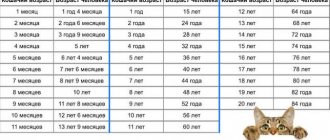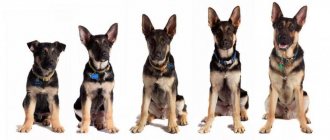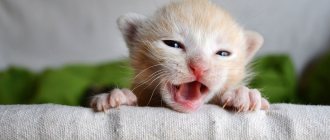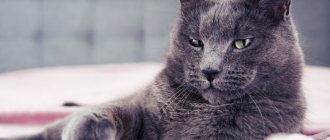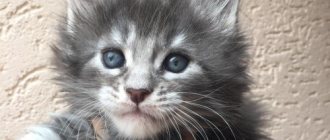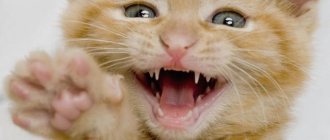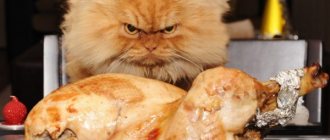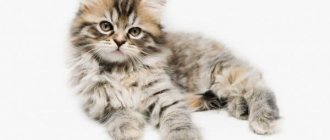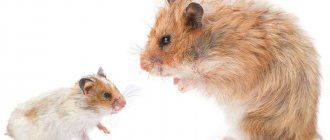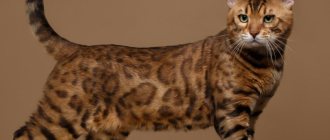Why do you need to know the age of cats?
Having found out how old your pet is, you can properly adjust its care, balance its diet, and better monitor its health. It is impossible not to take into account changes in years, because this will have a bad effect on the standard of living of your mustachioed friend. Why else might such knowledge be useful:
- Determine the level of physical activity, the intensity of which decreases with age. Excessive play with an elderly person will have a bad effect on the joints and cardiovascular system. But for younger people, lack of activity will negatively affect physical development or lead to dangerous obesity.
- The cat's health is monitored in accordance with physiological changes. For example, only older individuals are susceptible to cataracts. Therefore, caring for mature pets should be more thorough.
- The selection of diet must be correlated with the characteristics of the period of life. Nutrition must meet the needs of the body. For example, older cats find it difficult to eat dry food because their teeth have worn out and become more brittle. They are no longer adapted to rough food.
Knowing the degree of maturity, it is not difficult to help your mustachioed friend develop fully and provide him with good care and proper nutrition. The quality of life and attention of the owner will prolong the cat’s life.
Long-lived cats
Famous cats and cats - record holders for life expectancy:
- Lucy the cat – 39 years old (born in 1972, the record was registered during the cat’s lifetime in 2011), South Wales, UK
- Cat Cream Puff – 38 years old (1967-2005), Texas, USA
- Baby Cat – 37 years old (1970-2007), Minnesota, USA
- Cat Granpa Rex Allen - 34 years old (1964-1998), Texas, USA
- Scooter the Cat – 30 years old (1986-2016), Texas, USA
In the photo, the long-lived cat Cream Puff
There is no relationship between the breed of a cat and its lifespan. Representatives of indigenous breeds (Norwegian Forest, Siberian, Maine Coon) were distinguished by good health and longevity until they were affected by mass artificial breeding.
Periods of a pet's life
According to research by zoological scientists, the life of a mustachioed friend goes through different stages. Each of them is characterized by its own physiological, behavioral and psychological characteristics. There are 6 stages of cat age:
- Childhood
lasts from birth to six months. This is a time of rapid growth, as well as formation until the onset of puberty.
- Youth
– period from 6 months to 2 years. This is the stage of preparing the body for adulthood. The growth of the mustachioed friend continues, but at a reduced pace.
- Heyday
– time from 2 to 7 years. This is the peak of increased physical and mental activity: the pet has a strong skeleton, healthy teeth and beautiful coat.
- Maturity
– stage from 7 to 11 years. Then a slight decrease in physical activity begins, but in general the cat’s age is not so noticeable.
- Elderly age
– stage from 11 to 15 years. Vitality is gradually lost. The appearance and quality of fur, claws, and teeth deteriorate. The first health problems appear.
- Old age
. After 15 years, a decrease in various types of activity is clearly expressed, sleep time increases, and an increased risk of various diseases arises.
This division into stages becomes fundamental when understanding the degree of maturity of a cat. Awareness helps in proper care and maintenance. Veterinarians quite easily determine the age of a cat based on physiological data and behavioral characteristics of each period.
Age comparison principles
There is an opinion that in order to calculate the age of a cat by human standards, it is enough to multiply it by seven. In fact, this approach is only valid for animals between three and ten years of age.
They grow up and grow old at a completely different pace than humans.
It is necessary to take into account the principles of recalculation:
- There is no calculation formula for cats under three years of age.
- A three-year-old animal reaches approximately the same degree of development as a person at 25-30 years old.
- From three to five years, this figure increases by 7 every year.
- From five to twelve years – by 4.
- After twelve years, each year is counted as 3.
Determining the number of years lived
It is difficult for an inexperienced owner to determine the age of a cat without the help of a specialist. An experienced breeder is able to accurately indicate the age of his pet, but it would be best to show the animal to a veterinarian. The specialist will not only tell you how old the cat is, but will also paint a general picture of her condition. In veterinary practice, there are several criteria for determining the age of animals.
According to the condition of the teeth
Veterinarians can easily determine the amount of time an animal has lived by looking at its teeth. This method is effective for different individuals, from kittens to old people. This fact can be explained by the fact that the schedule for replacing baby teeth with molars is quite strict. The strength of the fangs and their color are the best indicators of not only the health of the pet, but also its maturity.
| Number of years | Condition of the oral cavity |
| 5 weeks | Baby teeth erupting |
| 6 months | Dairy products are completely replaced by permanent indigenous ones. |
| 1 year | The canines should be in the best condition, white and strong |
| 1.5 years | The incisors on the lower jaw begin to wear off |
| 2 years | The enamel becomes yellow in color and traces of deposits appear |
| 4-5 years | The incisors on the lower jaw wear away very noticeably |
| 6 years | Abrasions on the fangs begin to appear, dark spots appear on the enamel |
| 7 years | The surviving incisors are completely worn away. Fangs in poor condition |
| 10 years | Half of the teeth are lost |
| 13-15 years old | Fangs fall out |
Table 1. Age of cats according to dental condition
The influence of time lived on the condition of the oral cavity is very noticeable. Unfortunately, the owner rarely pays attention to this and is in no hurry to change the pet’s diet when necessary. It would be a good idea to make periodic visits to a veterinarian-dentist, who will assess the condition of the oral cavity and tell you how to prevent teeth from wearing out too early.
According to the condition of the coat
The pet's appearance helps determine a cat's age. This method of definition is the most understandable for a non-specialist. However, veterinarians do not consider this method to be unambiguous, because environmental factors and living conditions can affect the condition of the coat and skin. Good care plus a balanced diet allows you to maintain an excellent appearance even in older individuals. There are only generalized signs that help determine the degree of maturity of a pet.
| Number of years | Type of coat |
| 0-1 | Hair is soft and shiny. There are no signs of baldness or tangles |
| 1-7 | A healthy individual has fur in excellent condition: smooth, fluffy, with a good pattern. Gray hair is completely absent |
| 8-15 | The hair is dull and thin. Tangles and bald spots often appear |
Table 2. Age of cats according to coat condition
This method of determination has many disadvantages. Representatives of some breeds have no hair at all or their hair is quite short and coarse. This makes it much more difficult to figure out changes over the years.
According to changes in the musculoskeletal system
Proper distribution of physical activity helps maintain energy and lightness until old age. In this regard, changes in the skeleton do not become a sign that the owner pays attention to. However, for a veterinarian, bones and muscles are the best indicator of a pet's maturity.
In mature individuals, the muscles are developed in proportion to the skeleton. After final puberty, the pet acquires the characteristic features of the breed’s exterior. In addition, a mature musculoskeletal system has a number of common features:
- pronounced muscle relief;
- gracefulness and ease of movement;
- increased activity, endurance.
In older animals, after 8 years of life, the first signs of aging begin to appear. They are not too noticeable, but already create inconvenience for an active individual. The changes are clearly visible in short-haired breeds. Such manifestations include:
- Sunken spine, protruding shoulder blades.
- Lack of ease of movement. Sometimes they are given to an elderly pet with great effort.
- The volume of muscle tissue decreases noticeably, and the remaining muscles become decrepit.
Aging felines often suffer from thinness. If the pet has excess fat, then some criteria are noticeably smoothed out. The most obvious sign of this is difficulty moving.
According to eye condition
The eyes are not the most accurate way to determine old age, since noticeable changes only begin in older animals. Until the age of 10, the eyes of kittens and mature cats are almost no different.
An indicator of old age is the iris, which can be:
- cloudy;
- covered with patches;
- with uneven, blurry edges;
- with faded color.
An eyesore also indicates that the cat's youth has passed. A non-obvious sign is that the eye becomes very wet, but this does not happen in every older cat.
How to extend the life of a cat
The following factors influence a cat's lifespan:
- Self-walking. Vagrancy should be avoided; in urban conditions, letting a cat out of the house unattended is doubly dangerous. Such walks often end in injury, incurable infection (viral leukemia, immunodeficiency) and death. It is better to fence the dacha area so that the cat cannot leave its boundaries, or equip it with a spacious enclosure.
- Nutrition. The diet should be fresh, balanced, and appropriate to the age of the animal. Industrial feed should be chosen at least premium class. If ready-made food is not suitable for some reason, the cat should be prepared separately; you should not feed it food from the human table.
- Regular vaccination. It is necessary to vaccinate all pets, including those who do not leave the house (the causative agent of the infection can come from the outside, from the owner’s shoes or clothes).
- Control of reproduction. It is best to neuter your pet. In fertile cats, do not give birth more often than once every 1-2 years (at the age of no earlier than 2 years and no later than 6-7).
- Veterinary control. At the first sign of illness, your pet should be seen by a doctor. For older cats, an annual preventive examination is recommended, including a general examination, blood, urine and feces tests, and consultation with a cardiologist.
- Living conditions. The cat should have a resting place in the house, where no one will disturb it, and enough toys for active pastime. The litter tray must be placed in a secluded place and kept clean.
Compliance with the rules of keeping, love, creating a calm and friendly atmosphere in the house is the key to a happy and long life for your pet.
Cat to human age ratio
Experts name three methods for comparing the life periods of people and cats. Unfortunately, none of them is considered absolutely accurate, so the age of a cat by human standards is always only approximate.
First way
The starting point is 1 year. This period is the time of puberty of the animal. This age corresponds to 16 years of age. Another milestone is 2 years, at which time the formation of the pet’s character and habits ends. This happens at 24 years old by human standards. After 3 years, the pet’s maturity is determined using the formula:
x = 24 + ((number of years – 2) * 4)
For example, your cat is 6 years old. This means you need to subtract two (you get four), multiply by four (you get 16), and then add twenty-four. It turns out that a six-year-old cat, by human standards, is exactly 40 years old.
Second way
Another method is to calculate the number of years in each of the three periods of life. This method is considered more accurate than the previous one due to the detailed nature of the calculations. The degree of maturity can be determined using the following formulas:
| Number of years (z) | Formula |
| 1-5 | x = z * 7 |
| 6-11 | x = (z – 5) * 4 + 35 |
| 12-20 | x = (z – 11) * 3 + 59 |
Third way
This technique has a scientific basis and was developed by veterinarians together with zoological scientists. The basis is an indicator that takes into account the intellectual, psychological and physiological level of development, converting a cat’s age to a human age in the table.
| Number of years of the cat | Number of years of a person |
| 1 | 18-19 |
| 2 | 25 |
| 3 | 32-33 |
| 4 | 35-36 |
| 5 | 40-41 |
| 6 | 43-45 |
| 7 | 46-47 |
| 8 | 50-52 |
| 9 | 55-56 |
| 10 | 60-62 |
| 11 | 64-65 |
| 12 | 67-68 |
| 13 | 70 |
| 14 | 72-73 |
| 15 | 75 |
| 16 | 76-77 |
| 17 | 78 |
| 18 | 83 |
| 19 | 91 |
| 20 | 100 |
Table 3. Age of a cat by human standards
Despite such a detailed table, it should be remembered that an accurate comparison of two fundamentally different biological species is almost impossible. A cat's age by human standards can vary. The rate of development of human and animal organisms has few similar characteristics. Here it is worth taking into account the difference in breeds and gender differences.
Age ratio of kittens up to 12 months
Kittens grow up very quickly.
The most crucial moment occurs at the age of 1-3 months. The kitten adapts to the environment and switches from milk feeding to regular food. From the 4th month to a year, a more stable period. The baby grows, gains weight, discovers the world and puberty occurs. It is difficult to find a specific figure to estimate how many years one month of a kitten’s life will be. Our table allows you to most accurately convert the age of a kitten into human years, taking into account the physiology of development.
| Kitten age | Person's age |
| 1 month | 1.5 years |
| 2 months | 2 years |
| 3 months | 3.5 years |
| 4 months | 5 years |
| 5 months | 6 years |
| 6 months | 7 years |
| 7 months | 9 years |
| 8 months | 10 years |
| 9 months | 11 years |
| 10 months | 12 years |
| 11 months | 14 years |
| 12 months | 16 years |
Is it possible to increase the lifespan of a cat?
Any owner dreams of having a furry family member to please him for as long as possible. And he has the power to do everything so that the cat lives for 15, or even 20 years. What will prolong the life of your beloved four-legged animal:
- Annual vaccination
. The kitten is vaccinated in the first 2-3 months of life and then the procedure is repeated every year. This will protect both your indoor and outdoor cats from the most terrible viruses with a high fatality rate.
- Routine examination by a veterinarian
. Non-pedigreed cats get sick less, so they can be shown to the veterinarian during vaccination once a year - just ask the doctor about this. Pedigree animals and animals with chronic diseases require more frequent visits to the veterinary clinic - the frequency will be determined by the veterinarian himself.
- Sterilization and castration
. If you do not plan to breed kittens, be sure to sterilize your pet - this will help avoid many problems, including diseases of the genitourinary system and mental disorders.
- Attention to any changes in your pet's behavior
. Has your cat started drinking a lot? Stopped sleeping in your favorite chair? Is he limping? Are there strange discharges? Even such little things require close attention from the owner. The first action in case of suspicion is to call the veterinarian, he will tell you whether you need to take the animal to the clinic or if you can watch it at home.
- Purity
- the key to health. Cats groom themselves, but this is not enough to maintain hygiene. For example, long-haired breeds cannot cope with caring for a luxurious fur coat, and it must be combed regularly to prevent parasites or skin diseases. It is necessary to thoroughly rinse the cat's food and water bowls, disinfect the trays, and wash the bedding.
- Nutrition
must be maintained at a high level. It is not so important what you feed your cat - the main thing is that the selected diet suits it. A young cat will benefit from both natural food and high-quality dry food. But kittens and elderly individuals require a special menu, which cannot be cheap. Therefore, before getting a cat, think about the fact that in old age, in 95% of cases, it will require greater expenses than in youth.
- Treat your cat like a family member
. Consider the nature of the pet and its needs. If she doesn't tolerate loneliness well, you shouldn't leave her in the apartment all day. And on the contrary - if the kitty loves isolation, respect her personal space. There are many such points, and if you do not pay attention to the psychological state of the animal, it will constantly be sick and will not live very long.
This is not a complete list of what a loving owner can do. The most important thing is to be attentive and patient, treating your pet as a younger member of the family. Then he will live very long and happily.
Life stages of cats
In cats, it is customary to distinguish three main stages of life - childhood and adolescence, youth and maturity, old age and old age. During these periods, the animal’s behavior and its relationship with the outside world change.
Childhood and youth
Childhood and adolescence are a period of learning useful skills and learning about the world. During this period, animals are especially active and energetic. By the age of two months, kittens develop normal coordination of movements, they feed independently and know how to use a litter tray. 2-3 months is the optimal age for handing over babies to new owners. Puberty begins at 4-6 months. By the age of one year, cats become fully grown, capable of obtaining food by hunting and bearing offspring. During childhood and adolescence, animals are still inexperienced, but curious, active and fearless, susceptible to infections, so at this stage you should create the safest possible living environment for them.
Youth and maturity
Young cats retain their youthful excess of energy and continue to gain life experience. During this period, the immune system finally matures. From 3-5 years old, animals become calmer, although they are not averse to playing with their owner and spend a lot of time hunting (including inanimate objects). Their regime is measured - food, entertainment and rest on a schedule. Cats are usually more self-sufficient; cats are more attached to their owner. This is the heyday of cat life, procreation.
Elderly and senile age
Elderly cats are calm and complacent; they like to be alone and sleep. These are wise animals that understand the person they love and trust perfectly. They are more conservative and often react to changes in the environment with stress and irritation. During this period, the immune response and the ability to thermoregulate weaken – the pet becomes sensitive to infections and does not tolerate heat and cold well. Elderly animals often react painfully to the arrival of a new pet in the house. At the end of its life, a cat needs to be protected from any changes and stress, and given enough attention.
Long-livers in the world of cats
You always want to believe that a pet will become a happy exception and turn into the smartest/obedient/beautiful/healthy/long-living cat in the world. And indeed, this sometimes happens - and not so rarely. But some cases are like a miracle.
Long-lived breeds
Before getting a purebred cat, it is advisable to find out what diseases it is predisposed to and how many years it lives on average. Breeds that can easily live 18-20 years include:
- Savannahs (one of the most expensive cats);
- Siamese cats;
- Manx;
- Persian cats;
- rexes (Cornish, Devon and others);
- Egyptian Mau;
- Burmese;
- Russians are blue.
Their life expectancy is due to good genetics and good health. However, this list can include the most common “breed” in the world – an ordinary yard cat. Outbred mustachios easily break records, living up to 20 years with good care and the absence of diseases.
Lifespan of cats and its extension
There is a pattern in nature: the smaller the animals, the shorter their life span. Cats are an exception in this regard - they live relatively long for their size. They usually manage to live to be fifteen to twenty years old.
The oldest one, according to the Guinness Book of Records, is 38 years old (about 145 years old by human standards).
Among the factors on which the longevity of these animals depends are the following:
- Breed. For example, Snowshoes live on average 11 years, American Bobtails - 13, Scots - 14, Persians, Sphynxes and British - 15, Maine Coons and Kuril Bobtails - 16, Tiffany - 18. Siamese, Thais and American Shorthairs, which often live up to 20 years.
- Lifestyle. Movement is a very important need for an animal. Passive pastime shortens his life.
- Nutrition. An unbalanced diet negatively affects the general condition of the body. Both a deficiency and an excess of certain substances have a negative impact.
- Sexual activity. Unsterilized cats and cats must have the opportunity to realize their sexual instincts - otherwise the hormonal balance in the body is disrupted.
- Psychological condition. Stress and emotional stress lead to neuroses and shorten life.
Based on this information, several simple principles of longevity can be identified: a balanced diet, an active lifestyle, a psychologically safe environment, sterilization if necessary and timely visits to the veterinarian.
According to research, the aging process in cats begins after about four years of age. Despite this, many animals feel great even in old age and remain active.
However, sooner or later, old age takes its toll, and owners begin to be interested in the issue of extending the life of their pet.
It is possible to slow down this process if you follow seven simple recommendations:
- Do not feed the animal “from the table”, use specialized complex feed of the highest quality. Give preference to poultry and lean beef. If the cat is accustomed to homemade food, the transition should be smooth.
- Do not give milk: it is contraindicated in adult cats because they do not produce the enzyme to digest it.
- Organize a proper diet, especially if the animal is prone to obesity. Avoid overeating.
- Provide the cat with conditions for active play and take walks outside.
- Maintain hygiene: periodically clean ears, eyes and teeth, comb out fur.
- Carry out prevention against parasites using anthelmintic drugs and anti-ectoparasites.
- Visit the veterinarian and get the necessary vaccinations.
Why find out the age of your pet?
The question of whether awareness is needed in a pet’s age is a logical question that has visited owners more than once. Whether we are dealing with a two-, four-, or six-year-old cat – does it matter? Indeed, some owners, regardless of the age of their pets, feed them the same food and do not change their caring habits for years.
Knowing your cat's age allows you to more effectively monitor his well-being.
Meanwhile, ignoring age leads to ignoring age-related characteristics and the inevitable changes in the body that occur in a cat’s body as it grows. The simplest example is that as cats age, their teeth wear down and turn yellow, which leads to the need to regulate the pet’s diet. It’s not for nothing that even the most budget-friendly foods have lines distributed by age.
What does the age of a cat affect?
Among the main reasons why you need to know the approximate age of a cat are the following:
- Knowing the age of your pet, you can more rationally distribute its physical activity and ensure that the cat does not become overtired. Many inexperienced owners literally “flirt” with older cats, whose activity is significantly reduced compared to young cats. The opposite situation is also possible - kittens at a young age lack play activity, which provides an outlet for accumulated energy;
Physical activity is important for both older and younger individuals, but it is important to dose it correctly
- The age of the cat must also be taken into account when monitoring its health. There are diseases that older cats are most susceptible to, such as cataracts. Caring for and maintaining the well-being of older and younger cats are fundamentally different;
Each age of the cat has its own approach to choosing vitamin complexes and medications.
Knowing your pet's age will allow you to choose the best nutrition plan that meets the needs of your pet. As mentioned above, cats' teeth do not last forever, even with daily care. With age, the fangs wear down, the teeth turn yellow, acquiring stones and caries. Older individuals are very reluctant to eat dry food, since it is a real test for their teeth, while many young individuals can use it.
Many cats change their food preferences as they age.
As already mentioned, one of the most common mistakes is ignoring the age of the cat when calculating its diet. Refusal of the same food, which an inattentive owner may take as a sign of capriciousness, ultimately often turns out to be an indirect request for a change in food. In addition, older cats lose their sense of smell, which prevents them from fully smelling food and developing an appetite. You can learn more about the specifics of feeding older pets below.
Features of feeding older cats
How to determine a cat's age by its teeth
To find out how old a cat is, you need to examine the teeth, namely the degree of wear on the incisors. There is a clear scheme according to which you can pick up a pet and determine the age indicator:
- 1 month - the cat is cutting its first teeth;
- 5-6 months - baby teeth are replaced by permanent ones;
- 1.5-2.5 years - noticeable wear on the incisors;
- 3.5 to 4.5 years - the incisors of the upper jaw are gradually ground down;
- at 5 years old, abrasion of the fangs is noticed, and at 6 years, the outer incisors are worn out;
- at 7-9 years – the surface of the incisors changes, which lends itself to friction, alternately of both jaws;
- At the age of 10-15 years, cats experience loss of incisors.
Analogy of the life periods of people and cats
Representatives of the cat breed can go through six main stages during their lives, from birth to old age. Cats, like people, tend to behave differently at different ages.
For example, it is easier to train a small kitten to use a litter tray than an adult cat. As a pet grows and develops, its skills, habits, and character traits are formed.
If we make a comparison between a cat and a person, we can draw the following conclusions:
- in both cases the baby is a helpless creature, completely dependent on the mother;
A newborn kitten is completely dependent on its mother cat
- in childhood, all children learn about the world around them and acquire certain skills;
- in adolescence, the cat and the person are active, but have no experience;
- young people and cats are full of strength and energy;
- in adulthood, experience and skills come to them;
- being old people, they gradually lose activity and the acuity of their senses.
Infancy
The infancy period in kittens passes much faster than in humans, and lasts until about 1 month. This time is the most difficult for a kitten: he learns about the world around him and begins to walk.
The kittens that are born are completely helpless; they do not see or hear anything. 5 days after birth, their eyes begin to open slightly, and a week later hearing appears. In the second week of life, baby teeth erupt. Translated into human age, this period corresponds to the age of 5–9 months.
At one month, kittens can run and jump, which corresponds to the age of children of 1 year and 5 months.
A month old kitten behaves like a one and a half year old child
Childhood
Childhood begins in the second month and lasts up to six months. During these months, pet development occurs very quickly, and it is not easy to compare it with the corresponding human years. A three-month-old kitten can be comparable in intelligence to two-year-old children.
Kittens at 4 months are active, mobile, spend time playing and communicating with other kittens. They can distinguish “us” from “stranger”; they sharpen their claws, lick their fur, wash themselves and eat.
Their innate instincts help them in this, and they also learn from their mother’s example to take care of themselves. During the first year of its life, a cat goes through all the stages of growing up. By human standards, the end of childhood corresponds to 14 years.
A kitten ends its childhood period at six months
It is during this period of time, when the kitten is growing up, that you need to pay attention to the issues of raising your pet in order to catch it before it develops skills and habits that are undesirable for the owner. For example, you should teach the animal that it is forbidden to scratch furniture or go to the toilet where it wants.
Youth
A cat's adolescence begins at 7 months and ends when he is one year old. Although the kitten is still growing at this time, its growth rate is slowing down. Cats reach puberty.
During adolescence, the cat begins puberty
In long-haired breeds, the coat reaches its constant length. The animal gets used to the environment, to the available pets, and determines a distinct life routine for itself.
During adolescence and adolescence, you cannot treat a cat like a child, forgive its aggressiveness, minor dirty tricks such as leaving puddles. This will not go away on its own with age. Indeed, at this time, translated into human age, the cat becomes comparable to a teenager in adolescence, and significant changes are observed in his behavior and character.
Youth
A cat's youth ranges from 2 to 6 years. At this stage of life, the cat feels strong, he is tireless and dexterous.
The young cat is full of strength and dexterity
Youth (in humans it begins after 20 years) is the best time for a purebred pet to be able to participate in all kinds of exhibitions and competitions. This period is also ideal for conceiving healthy offspring.
Maturity
The cat's maturity period ranges from 7 to 10 years. For a person, these are years from 40 to 55.
Mature age occurs when the cat is over 7 years old
At such times, cats become calm, but sometimes they can play. Professional breeders of purebred animals that have reached adulthood stop breeding them.
Old age
Cats over 11 years of age, sometimes living to 20 years or more, are considered seniors. The venerable age of the animal does not at all indicate its imminent death. A cat's longevity depends on its health and conditions of detention.
A cat becomes elderly after 11 years
Pets, for example, often exceed the life span of 16 years, and street cats live no longer than 10 years. With good care, cats feel great in old age.
The family pet, the Persian cat Kuzya, delighted those around him with his presence for 14 years and lived to an old age. Throughout his life he was always active and inquisitive.
Video: caring for an old cat
By the eyes
Eyes are not only the mirror of the soul, but also an important indicator of a pet’s age. How to find out the age of a cat at home using this criterion? It is enough to observe the behavior of the animal a little. Young cats have a lively gaze, quickly moving to an interesting object, and a little mischievous. At advanced age, these properties usually become dull.
It is worth paying attention to the structure of your pet's eyes. In a young animal, the glassy substance is smooth, without inclusions, and transparent. The iris is of even color and regular shape. In old cats, over time, the eye becomes cloudy and dull, and separation or destruction of the vitreous substance appears. The iris, which usually becomes deformed and thinner, has streaks and spots.
Important! Discharge from the eyes, clouding of the cornea, or spots on the iris may be a sign of an infectious disease or organ injury. At the first symptoms, contact your veterinarian.
Pets at a very advanced age develop wrinkles (folds) around the eyes. Discharge (watery or purulent) often forms from the lacrimal sacs.
How to calculate how old a cat is based on signs of puberty
Cat puberty is considered the simplest answer to how to determine the age of a cat. Mostly it begins at the age of 7-9 months, and, having sheltered a purr in the house, you just need to wait for this moment. But, in some cases, cats mature a couple of months earlier, therefore, this method is relative.
A cat's puberty is indicated by the specific smell of urine when trying to mark its personal territory. Cats become especially affectionate at this time and meow loudly. Once heat begins, they are constantly surrounded by cats.
How to determine a cat's age by weight
A cat's weight will not accurately determine its age and is the least accurate way. It largely depends on the gender and breed of the cat, and physical characteristics. Only very approximate figures can be taken into account here.
| Age of the cat | Weight |
| 1 month | 500-750 g |
| 2 months | 1-1.5 kg |
| 3 months | 1.7-2.3 kg |
| 4 months | 2.5-3.6 kg |
| 5 months | 3.1-4.2 kg |
| 6 months | 3.5-4.8 kg |
So, at the age of 6 months, according to this table, I weighed a little less than I should, as if I was a whole month younger. Therefore, if you are not sure of the methods to help determine the age of the animal, you can take your pet to a veterinarian, who will help answer the question of how old the cat is and give recommendations regarding the necessary care.
